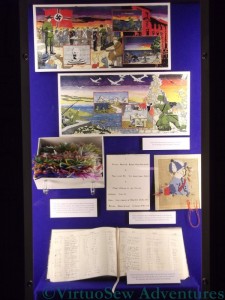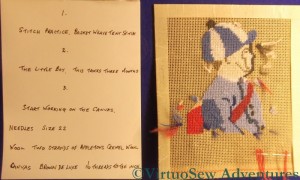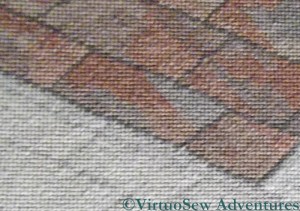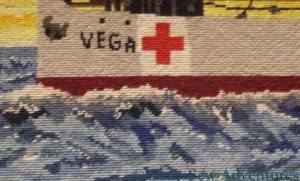Worth A Visit – The Jersey Occupation Tapestry
Regular readers will know that I like large projects for myself; it won’t have been so obvious that I am interested in community or group projects as well. Not just the stitching, but the inspiration, organisation, management and quality control necessary to bring such projects to a successful conclusion.
And make no mistake – quality control can be a serious issue. Often you will hear it suggested that volunteers can’t be expected to do good work, or that, because they are volunteers, anything they produce, however sloppy, should be accepted with enthusiasm and gratitude.
Well, I’m sorry, but I don’t agree. Volunteers should be expected to want to do well, and to practise to make sure that they do.
The volunteers who stitched the Jersey Occupation Tapestry were asked to stitch sample pieces before starting on the real thing. The twelve panels of the Tapestry are worked entirely in Basketweave Tent stitch, which is an easy stitch – but that very simplicity means that there are no textural variations available to hide variations in technique. So all the stitching had to be right. And it was.
The panels were designed by a curator at Jersey Heritage, who then drew out the designs on canvas and marked the thread colours for each element. In the case of seas, skies and such sections, he suggested a range of colours and allowed the stitchers to use their own artistic skills to bring those elements to life. If you look at the photos, I think you’ll agree that his faith in them has been triumphantly justified.
The Jersey Occupation Tapestry Gallery is part of the Maritime Museum in St Helier, and was worked to commemorate the Liberation of the Channel Islands in 1945. Unlike some textile galleries, they don’t mind photographs being taken, although as the panels are displayed behind glass, flashes would be counterproductive as well as unpopular! The display includes some details about Albert Bedane, and a video about the making of the tapestry. Some of the stitchers were children on the island during the Occupation, and some of their memories are included in the designs.
Altogether I had a fascinating time, and can recommend it highly!





I like community projects as well! I had not heard of the Jersey Occupation Tapestry before. It does look splendid!
I agree that skill is important for these pieces along with a commitment to see it through.
Fascinating community project – such an interesting story.
I hadn’t heard of this project – thank you for sharing it with us!
Having organised a number of community projects I know all the things that can go wrong and right. The project that has most inspired me was the Quaker Tapestry in Kendall (UK). They have documented how every step was organised and considering they had volunteers on a number of continents the quality control was amazing. I must delve into this one it sounds interesting.
Fascinating! The key to success in something like this is to have people who love the work, love doing it and thusly will do it well. Looks that has all been accomplished.
Do you know if any of the older stitchers were living on the island then? (does some rapid mental arithmatic). Maybe not. Next generation?
Wish I were there to view the beautiful artworks.